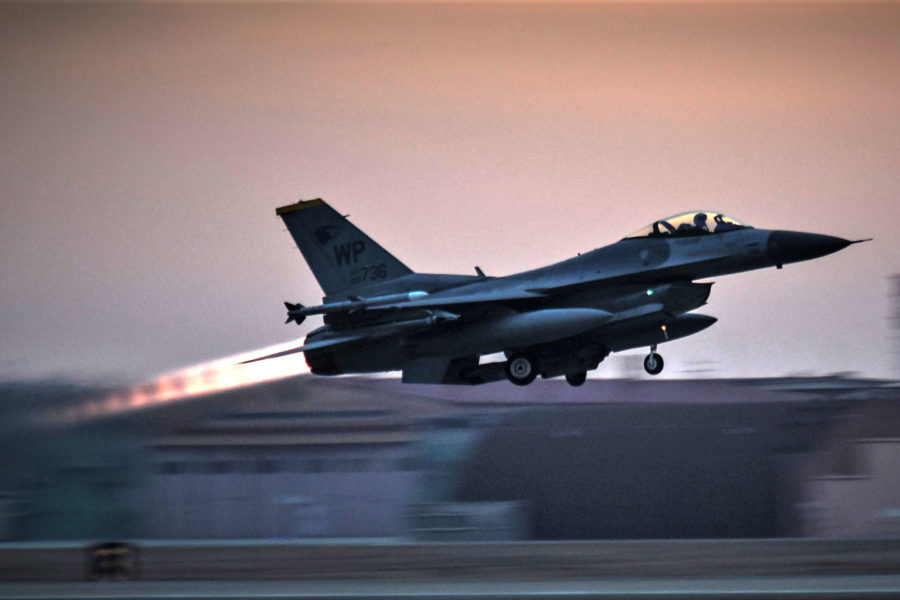A critical failure of an F-16’s navigation system and its backup, coupled with poor weather conditions, led to a crash off the coast of South Korea last December, destroying the $28 million fighter, according to an Air Force Accident Investigation Board release Sept. 26.
The F-16 was flying from Kunsan Air Base, South Korea, for a training mission on Dec. 11, 2023. The pilot, who ejected safely, sustained no serious injuries and was returned to full flight duties a few weeks later.
The investigation found the crash was primarily due to a failure in the aircraft’s embedded global positioning and inertial navigation system known as EGI. The EGI combines GPS and inertial navigation that tracks movement using onboard sensors. When the EGI fails, the pilot loses access to critical navigation and must rely on backup instruments.
But in this case, the backup also failed the pilot; investigators faulted a malfunctioning backup Standby Attitude Indicator (SAI) and poor weather conditions with limited visibility as causes of the pilot’s disorientation that contributed to the crash. The SAI shows the jet’s orientation—whether it’s level, climbing, or turning.
Although the exact cause of the EGI failure remains unclear due to the loss of the black box, a power outage is suspected to have triggered the malfunction, as seen in similar past incidents.
“Based on the data available, I could not determine why the EGI malfunctioned,” Col. Philip Lancaster, the board president, wrote in the report. “The ‘most likely’ cause of failure is a loss of power which may or may not be visible to the pilot.”
The incident began shortly after the 8:23 a.m. takeoff of a four-ship formation of F-16s from Kunsan during a routine exercise. The pilot involved in the mishap encountered dense cloud cover, forcing him to rely fully on the aircraft’s navigation system to fly, a state known as instrument meteorological conditions (IMC).
About 15 minutes into the flight, the jet’s EGI system malfunctioned, wiping out the pilot’s critical navigation and attitude displays that are essential for keeping the plane level or on course.
“The absence of the EGI failure while in IMC may have prevented this mishap,” the report stated.
With the EGI down, the pilot tried to rely on the backup SAI, which had already shown some faulty pitch and bank data earlier in the flight. Hoping for clear skies, the pilot then started a descent through the clouds.
The system kept giving conflicting readings, showing a climb while airspeed and altitude instruments indicated a descent. This mismatch of data with the cloudy conditions led to the pilot experiencing spatial disorientation—a condition where the pilot could not accurately interpret the aircraft’s position relative to the horizon.
“After transitioning to the SAI, the Mishap Pilot had difficulty maintaining level flight and overall spatial orientation due to the weather conditions and a poorly performing SAI, so the [pilot] prioritized a descend below the forecasted ceiling (believed to be 3,500 ft) where clear sky was expected,” the report stated.
The pilot told one of his wingmen to follow closely, about 500 feet behind, while relaying altitude and airspeed information during the descent. However, the report noted that radar data alone from the other F-16 wasn’t enough to resolve the mishap pilot’s spatial awareness. When the other pilot’s radar showed the mishap plane slightly climbing, the mishap aircraft’s SAI still indicated a nose-up position with continued altitude loss.
“When unable to find airspace free of clouds at 3,000 feet, the Mishap Pilot attempted to level off, causing further disorientation,” the report read.
At around 8:42 a.m., the pilot attempted to eject, though without the black box data, the exact timing and aircraft position at ejection remain uncertain. Shortly after, the F-16 crashed into the Yellow Sea, approximately 81 nautical miles west of Kunsan. The jet, belonging to the 8th Fighter Wing, was completely destroyed, with a valued loss of $28,259,045. The pilot was rescued by a Republic of Korea Navy ship and treated for hypothermia.
Since last year, Kunsan has experienced three F-16 crashes, occurring in May and December of 2023, and January of this year. No personnel have been injured in any of the crashes, and the Air Force has stated that the incidents do not appear to be related.
“The Air Force is working to limit the impacts of temporary power fluctuations on flight instrument systems in the F-16,” the service said in a statement following the release of the report.
The investigation report for the third F-16 crash in January this year is still being conducted and its results will be published “as soon as they are available,” the statement added.


